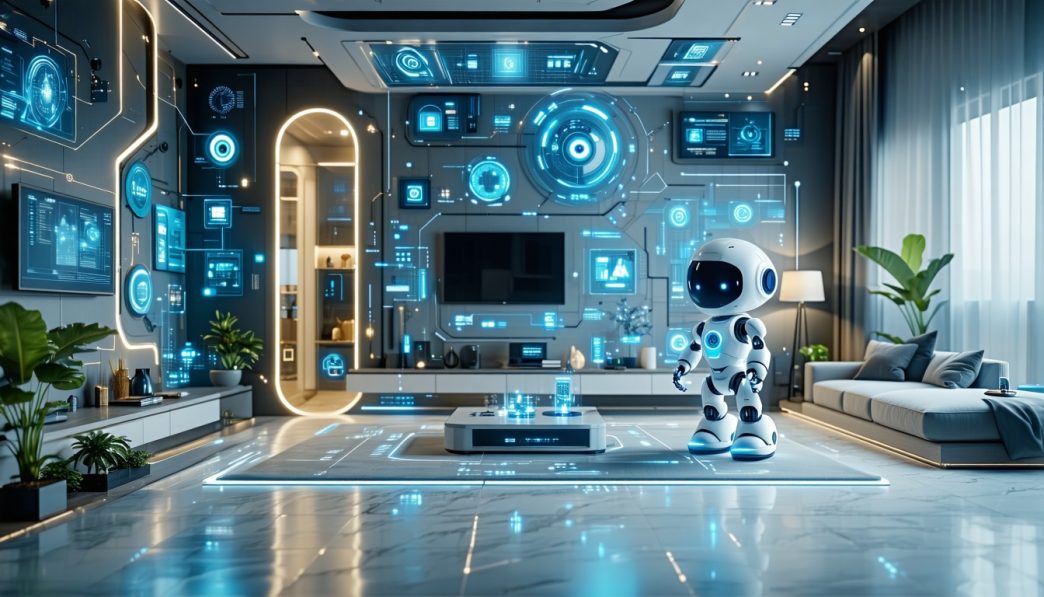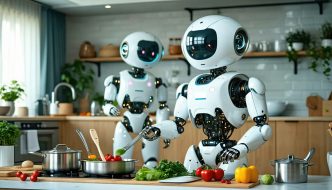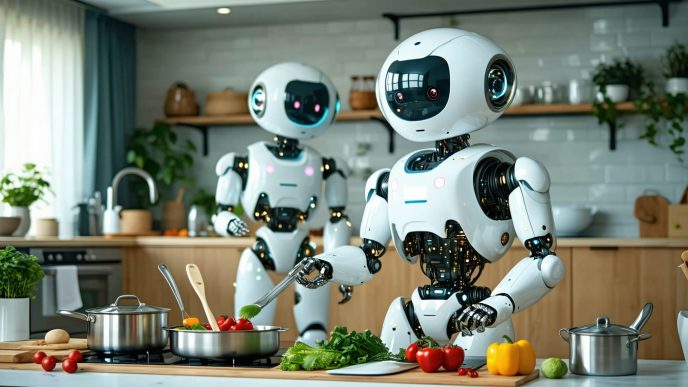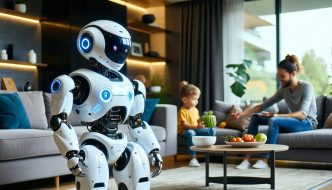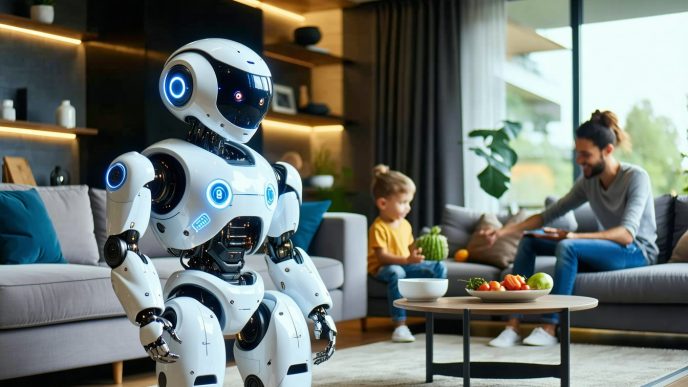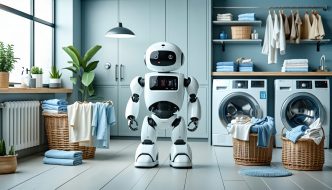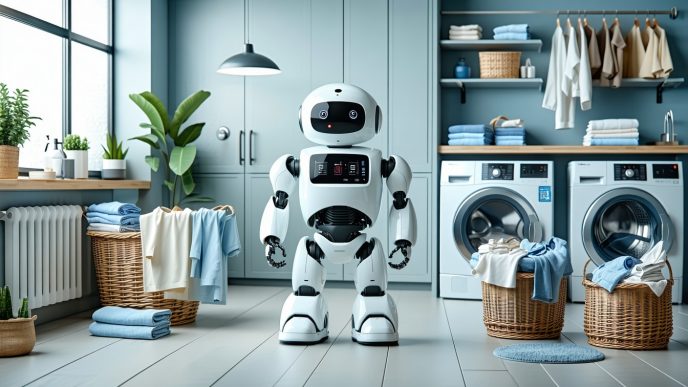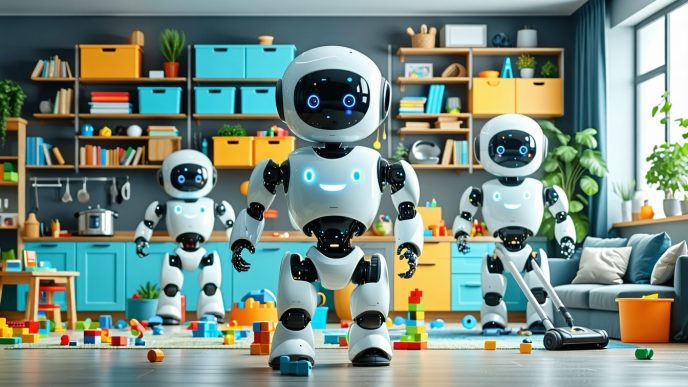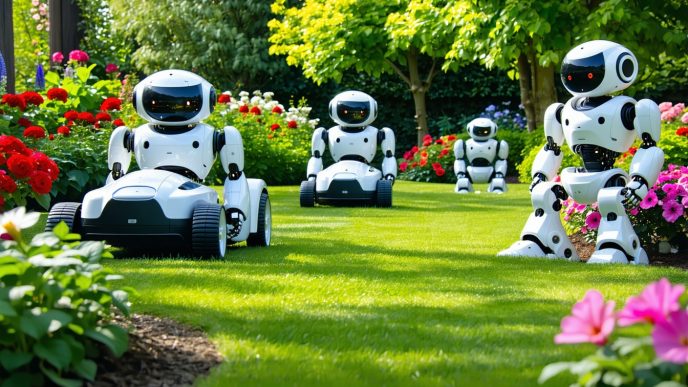The Role of AI and Robotics in Home Life
Introduction to Household Automation
The future of household automation involves integrating artificial intelligence (AI) and robotics into everyday tasks within the home. This technology aims to streamline home management, making life more efficient and convenient for families and homeowners. Automation systems can perform a variety of functions, from cleaning to security, allowing individuals to focus on more important aspects of their lives.
Household automation begins with smart devices that connect to a central hub, enabling seamless communication and control. This level of connectivity makes it possible for household tasks to be managed remotely, providing homeowners with the ability to monitor and control their environment. The incorporation of household task robots represents a significant advancement in this field.
| Type of Automation | Functions |
|---|---|
| Basic Home Automation | Lighting control, thermostat management |
| Cleaning Automation | Robot vacuums, automated mopping devices |
| Kitchen Automation | Smart cooking appliances, inventory management |
| Security Automation | Automated security systems, surveillance robots |
Advantages of Incorporating AI and Robotics in Homes
Integrating AI and robotics into home life offers numerous benefits. These technologies can help busy professionals and families manage their daily routines more effectively. Here are some key advantages:
-
Time-Saving: Automation allows individuals to complete household tasks more quickly. For instance, robots can handle cleaning duties, providing homeowners with extra time for their personal or professional lives.
-
Reduced Workload: By delegating chores to robots, families can significantly lower the physical and mental load of managing a household. This ensures a healthier work-life balance.
-
Increased Efficiency: Smart devices can perform tasks with precision and consistency. For example, automated cleaning systems can navigate around furniture, ensuring thorough cleaning without manual intervention.
-
Enhanced Safety: Many automation systems, such as smart security cameras and surveillance drones, enhance home security. This is crucial for providing peace of mind to families and individuals.
-
Improved Lifestyle: Household automation can lead to a higher quality of life. With more free time, individuals can spend quality time with loved ones, pursue hobbies, or focus on health and wellness.
| Advantage | Description |
|---|---|
| Time-Saving | Automation expedites household chores |
| Reduced Workload | Robots lessen the physical demands of home management |
| Increased Efficiency | Devices perform tasks accurately every time |
| Enhanced Safety | Smart security features keep homes secure |
| Improved Lifestyle | More free time enhances personal fulfillment |
Intrigued by the possibilities? Discover various applications of household robots such as cleaning robots, laundry assistance robots, and kitchen cleaning robots. As the future of household automation unfolds, these technologies are set to transform how families manage their homes and enhance their daily living experiences.
Smart Home Assistants
The integration of smart home assistants into household environments plays a significant role in the future of household automation. These innovative technologies simplify daily tasks, enhance convenience, and improve overall quality of life for families, homeowners, and busy professionals.
Virtual Home Concierges
Virtual home concierges are sophisticated AI systems designed to act as personal assistants within the home. They help manage various household tasks, provide reminders, and facilitate communication between smart devices. These concierges can learn user preferences over time, allowing for a more personalized experience.
Key features of virtual home concierges include:
- Scheduling appointments and reminders
- Managing smart home devices
- Providing weather updates and news briefs
- Handling grocery and shopping lists
Below is a table summarizing core functionalities of virtual home concierges:
| Feature | Description |
|---|---|
| Task Management | Organizes and schedules daily tasks and appointments |
| Home Automation Control | Interfaces with smart home devices for seamless control |
| Information Retrieval | Provides updates on news, weather, and notifications |
These virtual assistants contribute to reducing workload, allowing residents to focus on more meaningful activities. For more on how household task robots enhance daily living, explore our article on household task robots.
Voice-Activated Devices
Voice-activated devices are another pillar of household automation, offering hands-free control over various tasks. With natural language processing capabilities, these devices can respond to spoken commands, enabling straightforward interaction without the need for manual controls.
Common applications of voice-activated devices include:
- Music and entertainment playback
- Home lighting and temperature adjustments
- Setting timers and alarms
- Controlling security systems
The following table highlights the versatility of voice-activated devices:
| Command Type | Example Action |
|---|---|
| Music Playback | “Play my favorite playlist” |
| Home Control | “Turn off the living room lights” |
| Timers and Alarms | “Set a timer for 20 minutes” |
By incorporating voice-activated technology into their daily routines, users can efficiently manage household tasks. Individuals looking to organize their homes can find more helpful information in our article on robots assisting with organizing and tidying.
The combination of virtual home concierges and voice-activated devices is reshaping the landscape of home life, paving the way for seamless routines and smarter living. As technology advances, these features will continue to offer solutions that cater to the needs of modern families and busy professionals.
Automated Cleaning Systems
With the increasing demands of daily life, families and busy professionals are turning to automated cleaning systems to ease their workload. These systems include innovative devices such as robot vacuums and automated mopping devices, which are transforming the future of household automation.
Robot Vacuums
Robot vacuums represent a key advancement in home cleaning technology. These autonomous devices are designed to navigate around homes, efficiently removing dust, dirt, and debris from various surfaces. Equipped with sensors and smart technology, robot vacuums can map out spaces and avoid obstacles, ensuring thorough coverage of the floor area.
| Feature | Description |
|---|---|
| Battery Life | 60 – 120 minutes |
| Dustbin Capacity | 0.3 – 0.7 liters |
| Navigation Technology | Mapping, cliff detection |
| App Connectivity | Yes, for scheduling and control |
Robot vacuums can be programmed to operate on a set schedule, allowing homeowners to return to clean floors without any manual effort. For more on using these devices, explore our article on household task robots.
Automated Mopping Devices
Automated mopping devices complement robot vacuums by tackling stains and spills on hard floor surfaces. These devices often combine vacuuming with mopping functions, making them multifunctional tools for home cleaning.
Automated mopping devices utilize microfiber pads and water tanks to effectively clean floors while offering various cleaning modes to suit different surfaces.
| Feature | Description |
|---|---|
| Tank Capacity | 200 – 500 milliliters |
| Cleaning Modes | Wet, dry, and spot cleaning |
| Smart Features | Scheduling and remote control |
Families can set these devices to clean specific areas at times that are convenient, significantly reducing manual cleaning time. For insights into keeping your home organized, check out our article on robots assisting with organizing and tidying.
The integration of robot vacuums and automated mopping devices into daily routines illustrates just one aspect of the ongoing evolution in home cleaning technology. As automation continues to advance, the efficiency and convenience of household chores will only improve, shaping a more effortless living experience.
Kitchen Automation
The evolution of kitchen automation is a key aspect of the future of household automation. Smart cooking appliances and automated inventory management systems are transforming the way families and busy professionals prepare meals and manage their kitchen needs.
Smart Cooking Appliances
Smart cooking appliances are designed to simplify meal preparation. These devices often connect to home Wi-Fi, allowing users to control them remotely via smartphone apps. They come equipped with features such as programmable cooking times, recipe suggestions, and real-time monitoring.
Some common types of smart cooking appliances include:
| Appliance Type | Key Features |
|---|---|
| Smart Ovens | Remote control, recipe suggestions, self-cleaning |
| Smart Slow Cookers | App control, customizable cooking times |
| Smart Pressure Cookers | Preset cooking programs, safety features |
| Smart Mixers | Recipe integration, precise temperature control |
These appliances reduce the amount of time spent in the kitchen, making meal prep more efficient for families and professionals alike.
Automated Inventory Management
Automated inventory management systems streamline grocery shopping and meal planning. These systems track kitchen supplies and alert users when items are low or need to be replenished. Advanced versions can even connect to online grocery services, allowing for easy reordering.
Key features of automated inventory management systems include:
| Feature | Description |
|---|---|
| Real-Time Tracking | Monitors supplies and updates inventory status |
| Integration with Smart Devices | Syncs with smart fridges and pantries |
| Recipe Matching | Suggests meals based on available ingredients |
| Online Grocery Ordering | Facilitates quick reordering of low-stock items |
This technology helps families manage their groceries more effectively, reducing food waste and ensuring they are always prepared for meal preparation.
As families and homeowners embrace these innovative solutions, the integration of smart cooking appliances and automated inventory management systems will significantly enhance daily living and increase efficiency in the kitchen. For more on household automation, explore our article on household task robots.
Personal Care and Wellbeing
The integration of AI and robotics in personal care and wellbeing is revolutionizing daily routines. These innovations not only enhance individual health but also contribute to a more balanced lifestyle. This section discusses robotic healthcare assistants and smart fitness equipment.
Robotic Healthcare Assistants
Robotic healthcare assistants serve a vital role in supporting individuals with various health needs. These robots can assist with medication reminders, vital sign monitoring, and even companionship for the elderly or those with mobility issues.
Key benefits of robotic healthcare assistants include:
- Medication Management: They can remind users to take their medication on time, ensuring adherence to prescribed schedules.
- Monitoring Health: Some robots can track vital signs such as heart rate and temperature, alerting caregivers if any abnormalities are detected.
- Companionship: These robots provide social interaction, reducing feelings of loneliness and isolation in vulnerable populations.
| Feature | Benefit |
|---|---|
| Medication reminders | Ensures timely adherence |
| Vital sign monitoring | Early detection of issues |
| Companionship | Improves emotional wellbeing |
These advancements highlight the impactful role of health-related robots in households, making them an essential part of the future of household automation.
Smart Fitness Equipment
Smart fitness equipment offers families and individuals new ways to achieve their wellness goals through technology. These devices include smart treadmills, stationary bikes, and fitness trackers, which help users monitor and enhance their physical activity.
Some features of smart fitness equipment include:
- Activity Tracking: These devices track progress, providing valuable data on workouts, calorie burn, and overall activity levels.
- Personalized Coaching: Many smart machines offer real-time feedback and tailored workout plans based on individual performance.
- Integration with Health Apps: Users can connect their equipment to health apps to monitor overall fitness and health metrics.
| Device Type | Key Feature |
|---|---|
| Smart Treadmills | Real-time performance metrics |
| Stationary Bikes | Personalized coaching |
| Fitness Trackers | Activity and health tracking |
Smart fitness equipment not only simplifies workout routines but also encourages family members to stay active together. For additional insights into household robotics, explore our article on household robots working with smart homes.
These advancements reflect the evolving landscape of personal care and wellbeing, as technology continues to play a significant role in enhancing health and fitness routines for families and busy professionals alike.
Security and Surveillance
Smart technology is reshaping the landscape of home security. Automated home security systems and surveillance robots are becoming essential components of modern household safety, providing families and homeowners with peace of mind.
Automated Home Security Systems
Automated home security systems integrate various technologies to monitor and protect properties. These systems typically include sensors, cameras, and alarms that can be controlled remotely via smartphone apps. Key features of these systems often involve real-time alerts, remote access, and integration with other smart home devices.
The data in the table below illustrates common components and features of automated home security systems:
| Feature | Description |
|---|---|
| Motion Sensors | Detect movement and trigger alerts |
| Door/Window Sensors | Signal when doors or windows are opened |
| Security Cameras | Provide video surveillance and monitoring |
| Smart Alarms | Notify homeowners of security breaches |
| Remote Access | Allow control and monitoring via apps |
Automated systems enhance security by providing 24/7 monitoring and the ability to respond quickly to potential threats. As a result, these systems have a significant impact on the future of household automation by promoting safer living environments.
Surveillance Robots and Drones
Surveillance robots and drones are advanced technologies that enhance home security measures. These autonomous devices can patrol the property, providing comprehensive coverage that human monitors may miss. They often utilize cameras and sensors to detect unusual activities and can send alerts to homeowners in real-time.
The following table outlines the various types and functionalities of surveillance robots and drones:
| Type | Functionality |
|---|---|
| Ground Surveillance Robots | Patrol defined areas and monitor for intrusions |
| Aerial Drones | Capture aerial footage and survey large properties |
| Mobile Security Robots | Navigate through spaces, providing real-time video feeds |
| Monitoring Drones | Conduct aerial surveillance and report anomalies |
These devices significantly improve home security, allowing for proactive monitoring and quick response to incidents. They represent an innovative step forward in safeguarding homes, aligning with the trend of household robots working with smart homes.
Incorporating automated security systems and surveillance technologies illustrates the transformative potential of robotics within household tasks, enabling families and busy professionals to streamline their security efforts while enhancing overall safety.


